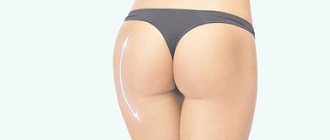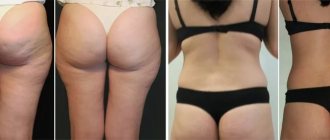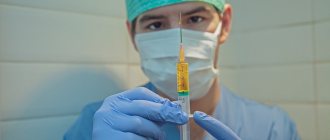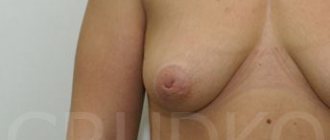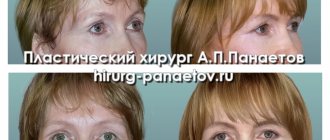Femoroplasty is a surgical operation aimed at correcting the inner and/or outer surfaces of the thigh and eliminating cosmetic skin defects.
Fat deposits in the thigh area grow rapidly and “go away” very slowly. Under their weight, thin skin, subject to friction, begins to sag. Femoroplasty not only tightens the skin, but also gets rid of excess fatty tissue and prevents further ptosis.
Factors that provoke skin ptosis in the thigh area are poor diet, sudden weight loss, previous liposuction without tightening sagging skin, a sedentary lifestyle, pregnancy and childbirth.
There are several techniques for performing femoroplasty, differing in the method of creating access to soft tissues and the purposes of application:
- median (through the inguinal folds) - used to eliminate minor sagging with a slight excess of adipose tissue;
- vertical (through a wide incision from the gluteal folds to the knee) – used for complex correction and excision of a large amount of excess tissue;
- through incisions around the hip joints – used for immediate correction of the inner and outer surfaces of the thigh;
- combined - a technique that combines elements of several methods of femoroplasty, used when it is necessary to excise large flaps of skin along the inner surface of the thigh.
Contraindications
Femoroplasty is not performed if there are restrictions such as:
- Phlebeurysm.
- Predisposition to thrombosis.
- Blood diseases, incl. poor clotting.
- Various neoplasms.
- Endocrine disorders.
- Infections and viruses.
- Gynecological diseases.
- Menstruation, as well as 4 days before and after it.
If the patient has the listed contraindications during preparation, then to eliminate the imperfections of the hips it is worth considering cosmetic and hardware techniques - SplitFat Sistem, mesotherapy,
Are there any marks left after femoroplasty?
After midline femoroplasty, the scar is almost invisible and can be easily hidden under underwear. After vertical and mixed femoroplasty, a T-shaped scar remains, which is more noticeable than in the first case, but can also be hidden by underwear. The severity of traces of intervention largely depends on the quality of the skin and its regenerative function. In the future, collagen therapy/laser resurfacing can be performed to completely eliminate visible marks from femoroplasty.
Kinds
The procedure varies according to the type of surgical approach. The lift can be:
- Internal (middle or medial). Involves correction with an incision along the inguinal fold. Excess skin is excised, then the inner thigh is pulled up. Surgeons use this method for minor ptosis. The technology is the most gentle and carries with it the minimum of complications.
- Spiral (external or lateral). The scalpel passes around the thigh - from the inguinal fold the cut goes to the subgluteal and again to the groin. Suitable for such indications as sudden weight loss. The skin is tightened on all sides of the upper leg, and the contour of the buttocks is also corrected. This technology is often combined with gluteoplasty. This type of femoroplasty is more traumatic because the scars are deeper.
- Vertical. The incision runs along the inside of the thigh and resembles a triangle, starting from the groin and tapering towards the knee. The skin wedge is removed and the wound is sutured with horizontal sutures. The method is appropriate for a large area of sagging dermis.
- Combined. It implies a combination of the above types with each other. Ellipsoidal incisions are made. Used for grade III and IV ptosis.
Buttock augmentation using injections
Poly-L-Lactic Acid Sculptra
You can get toned, rounded buttocks not only with the help of surgical plastic surgery, but also with drugs based on poly-L-lactic acid. This is an excellent alternative to complex surgical procedures that does not require long-term rehabilitation and does not cause complications.
Poly- L - lactic acid
is a synthetic biocompatible and biodegradable polymer for buttock augmentation. During destruction, polylactides are destroyed into non-toxic products and are excreted from the body along with biological fluids. The drug is immunologically inert, takes root well, and does not cause rejection. Belongs to the family of alpha hydroxy acids.
Sculptra
- one of the best drugs based on poly-L-lactic acid with a prolonged effect. The result after administration of the substance lasts up to 3 years. This polylactose acid hydrogel is absolutely safe, as proven by its many years of clinical use in practice. The skin of the buttocks becomes toned, elastic, and signs of aging completely disappear.
The drug works in the deep layers of the dermis and not only has a mechanical effect of increasing volume up to 4 cm, but also stimulates the body's reaction, causing the production of its own collagen, thereby restoring the collagen framework of the skin. Sculptra is officially approved by the FDA and is successfully used in many countries around the world.
Preparation
During the consultation, the surgeon evaluates the condition of the hips and identifies the cause that led to ptosis. To identify contraindications, the doctor gives a referral for testing.
Before plastic surgery, you must adhere to the following preparatory recommendations:
- Increase water consumption to three liters per day.
- Give up cigarettes and alcohol. Bad habits affect wound healing.
- Limit intake of aspirin and hormonal drugs.
- Postpone sports training for at least three to four months.
- Stick to a diet.
Benefits and effect
After injection of the filler, a swelling effect is observed. Enlargement of the gluteal muscle using injections is a popular procedure with many advantages:
- safe, immunologically compatible;
- outpatient;
- no anesthesia required;
- optimal results at a reasonable price;
- increase in volume up to 4 cm;
- short rehabilitation;
- no scars remain;
- accompanying lifting effect;
- natural look.
The effect of the procedure lasts on average up to three years - this is the longest period of action for a biodegradable group of substances. When the effect of the drug ends, the course can be repeated. As a result, you will get toned, smooth, firm and enlarged buttocks.
Progress of the procedure
Femoroplasty technology involves the use of general anesthesia. The correction usually lasts about three hours.
The operation begins with marking and an inhalation or intravenous anesthetic injection. After which incisions are made, the fat layer and excess skin are removed. The last step is suturing using the layer-by-layer method. When lifting the thighs, this point is important and the final result depends on it. Otherwise, tissue displacement or damage to the genital organs may occur.
First, the surgeon places internal sutures on the fascia of the thigh muscles, after which the skin is stitched with double threads. In this case, the edges of the dermis should not fit tightly to each other to avoid the appearance of rough keloid scars. The procedure ends with the installation of drainage tubes and application of a sterile dressing.
Non-surgical thigh lift methods
The task of plastic surgeons at the CONSTANTA Clinic is to choose the best solution to the problem, and not to perform an operation. Therefore, in some cases, they choose a hip correction method that does not involve complex surgical intervention.
- Liposuction . The method is used in cases where the problem of changing the contours of the hips is associated with excess adipose tissue. It is important that the patient has a good level of skin elasticity, which itself will adapt to the new contours. After liposuction, the patient must monitor his diet and lead a healthy lifestyle to maintain the results.
- Lipofilling . The technique is relevant for those with too thin hips. To add volume to the shapes, the surgeon injects the patient's own fat under the knees or in the groin area so that the scars remain as invisible as possible. Fat material is taken from areas where it is excess. Often, patients who need to correct the shape of their hips, as well as fill indentations that appear after injuries or unsuccessful operations with adipose tissue, resort to lipofilling of the hips.
Recovery
If there are no signs of tissue infection, the patient is allowed to go home on the second or third day. External sutures are removed on the tenth day, but sutures on the inner side of the thigh do not need to be removed, because they are made of self-absorbable threads.
Unpleasant phenomena such as pain, burning, fever, redness, swelling, and numbness persist for two weeks. To stop them, the doctor prescribes painkillers.
It is important to follow the recommendations for faster recovery:
During three months:
- It is forbidden to massage the thighs.
- Scars should not be treated with ointments and creams for quick healing. They will increase the swelling.
- It is necessary to avoid exposure to heat - baths, saunas.
- Limit exposure to the sun until the scar is completely formed, otherwise age spots may appear.
Within a month:
- To reduce the risk of complications, it is necessary to treat wounds with antiseptic solutions twice a day.
- To reduce the severity of swelling and bruises, be sure to wear compression garments. It reduces the likelihood of seams coming apart when walking.
During the first week:
- It is forbidden to bend over.
- You cannot get out of bed and sit.
- You are only allowed to lie on your back.
In addition, active sports are prohibited, but physical activity cannot be completely excluded.
Complications
Thighplasty has an increased risk of complications. This is due to the long incision during surgery. Therefore, it is not as popular as liposuction.
If the rules of the restoration process are ignored or the surgeon acts incorrectly, the following side effects are likely:
- Seromas. They occur when fluid accumulates in the wound. Eliminated by repeated drainage.
- Loss of sensation. A temporary phenomenon that goes away on its own.
- Increased sensitivity. Hypertension persists for life.
- Infection, suppuration. Treated with antibacterial therapy.
- Displacement of the genital organs as a result of tension in the groin skin.
- Thrombosis. Caused by prolonged bed rest.
- Formation of keloid scars.
- Slow blood circulation at the incision sites. The cause is tissue overtension. May lead to necrosis.
- Disruption of lymphatic drainage. You feel constant heaviness and swelling in your legs, because... lymphatic vessels are damaged.
We will help at any time
We are ready to tell you everything about hip surgery right now. Use the “Personal Manager” service. This specialist will fully provide information support for the preparation and conduct of corrective surgery at the Constanta Clinic in Yaroslavl and will resolve all emerging issues.
Call us by phone or notify us of your desire to use the service by email
Detailed information about preparation for plastic surgery and its implementation at the Constanta Clinic is here.
Reviews
Anyuta, 48
I've always been a curvy lady. Then she got married and gave birth to three children. After each birth, I gained more than 10 kilograms. When I sent my third child to kindergarten, I decided to go to work. But I realized that people were looking at me strangely. Then I noticed that everything was very bad with my figure. I have tried many weight loss methods on myself. The weight is gone, but the folds on the inner thigh remain. I couldn’t fight this on my own, so I decided to make an appointment with a surgeon. The femoroplasty went well and I was allowed to go home on the second day. The stitches have healed and turned into thin stripes that are almost invisible. Life became easier, the result simply exceeded all expectations.
Darina, 37
I decided to have a thigh lift after the skin on my thighs sagged after liposuction. The doctor assured me that the skin would tighten on its own and I didn’t need to think about it. But it can be easily pulled back with two fingers, and two years have already passed since liposuction. I realized that I could no longer hide my hips under clothes, so I made an appointment for a femoroplasty consultation. They told me in detail what I would get in the end. Now I'm happy with the appearance of my legs.
More
Indications for femoroplasty
Surgical correction is carried out for both aesthetic and medical reasons. In the first case, the operation is prescribed to eliminate cosmetic defects that negatively affect the patient’s psycho-emotional state, in the second - to correct too voluminous folds of skin and fat that interfere with walking and lead to diaper rash, abrasions, irritation and poor circulation. So, the indications for femoroplasty are:
- thickened subcutaneous fat layer on the inner/outer thighs;
- excess skin due to significant weight loss/muscle dystrophy;
- weak inner thigh muscles;
- anatomical disorders: bulges, unnatural folds, pits, uneven distribution of fatty tissue;
- cellulite;
- stretch marks;
- excess fat deposits, leading to chafing of the contacting parts of the skin;
- low skin tone, ptosis.
Plastic surgeons and clinics specializing in femoroplasty (hip surgery):
Mamedov Rusif Plastic surgeon
Specialization
- Mammoplasty
- Rhinoplasty
- Facial plastic surgery
Sergey Demin Plastic surgeon
Specialization
- Mammoplasty
- Abdominoplasty
- Lipofilling
- Liposuction
Farhat Fuad Plastic surgeon
Specialization
- Mammoplasty
- Abdominoplasty
- Cruroplasty
- Liposuction
Comments and questions
Natalya 01/30/2019 at 06:46 pm # Reply
Excellent article. Got all the answers in this article
